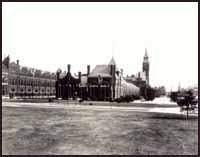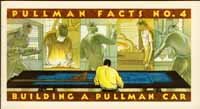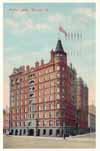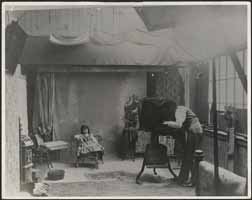The Water Tower
You are at Home -> The Pullman Company -> The Water TowerThe Water Tower
The water tower was located northeast of the Administration Building just outside the State Historic Site property. Its importance lies in the structural technology employed in its cage frame construction. It was 70' square at the base and 195' high, making it the tallest building west of New York surpassed only by Richard Morris Hunt's 260' high Tribune Building in NYC. Its load-bearing capacity was also much greater than virtually any other building in the country. The interior floors of the structure were supported by four massive phoenix columns resting on large, cone shaped concrete foundation piles. These columns were terminated at the eighth floor, where the two-story 500,000-gallon octagonal fire suppression water storage tank was located. The size of this tank and its height above the ground made for a water pressure of about 75 PSI. Potable water was purchased from Hyde Park Township (which included the Town of Pullman) and later the City of Chicago after Hyde Park was annexed into the city in 1893. Every house had iron sinks and faucets in the kitchen. The 40' subbasement contained three water pumps, four sewage pumps, and a 300,000 gallon sewage reservoir. All of the town's sewage was collected in this cistern then pumped to a company owned farm south near 130th Street where it was used as fertilizer. The floors between the water tanks contained shops where female employees made details such as tassels for the Pullman Cars. After manufacturing operations ceased in the water tower, the space was used to store engineering and accounting records. A Dairy farm, located near the sewage area, consisted of 420 acres by 1890 and supported 80 to 100 cattle. Sewage slurry from the water tower cistern was pumped here and used to fertilize the farm. Icehouses were maintained by the company as a paying investment. The icehouse workers in the winter worked in the brickyards in the summer.Accidental Destruction
The water tower was unintentionally demolished in 1957 when the Pullman Company was preparing the original and now obsolete manufacturing properties for subdivision. An ill-fated attempt to raze a nearby smoke stack resulted in the smoke stack collapsing into the water tower. The water tower was considered damaged beyond repair and razed. The building rubble was used to fill in the sewage cistern.

Article on the demolition of the smokestack and the burning of the Water Tower |
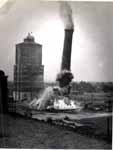
The destruction of the chimney |

The fire spreads to the Water Tower |
The Building's Artifacts
The foundation of the water tower was excavated in 2000 during a capital project on the site that triggered archeology mandates of a National Register Site. During the excavation, Pullman State Historic Site rescued building remnants that had been buried in the cistern for nearly a half century. Some of the water tower artifacts have been incorporated into the landscape of a community park at 111th and Langley Streets while others are stored for future exhibition and interpretation. They are visible at the northeast corner of the state historic site near the former site of the Corliss steam engine.A Historical Description
From: Doty, Mrs. Duane. The Town of Pullman. T.F. Struhsacker, Pullman, IL: 1893. Reprinted by the Pullman Civic Organization in 1974. This massive structure, sixty-eight feet square at the base and resting upon a heavy cut-stone foundation, rises to a height of 195 feet to the base of the flag-staff; it is 210 feet to the top of the flag-staff. The dimension stones of the lowest courses in the foundation are nearly 40 feet below the surface of the ground, resting on a blue clay so hard that blasting was necessary in making a portion of the excavation for the building. This great depth was necessary in order to secure the large underground cistern, into which the sewage of the city flows. The city sewage mains enter this cistern sixteen feet below the surface of the ground, and it has a capacity of 300,000 gallons. The cistern is covered with a floor of solid masonry, resting on piers and brick arches, and upon this floor, ten feet below the surface, sewage and water pumps are placed.There are three Blake steam pumps, with [a] capacity for pumping 60,000 gallons per hour. These pumps are connected so as to pump either Lake Michigan or Lake Calumet water. Their ordinary work is to supply Calumet water for the elevators and for shop use. But when it becomes necessary to fill the tank on top of the structure, the connection with Lake Calumet is closed and Lake Michigan water alone is pumped into the tank. There are two Cope and Maxwell compound condensing pumps for sending sewage to the farm. They have a capacity of 5,000,000 gallons per day, though they only have a third of that work to do.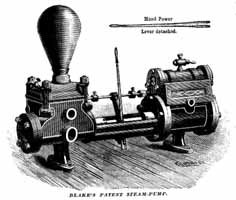
Blake's Simplex Steam Pump

The Edison Twin Arm Dynamo
THE PULLMAN HISTORY SITE

More Information About the Pullman Company
Products from the Factory
Edison Films of Pullman Travel

From A Romance of the Rail, 1903
Other Pullman-Related Sites
- Historic Pullman Garden Club - An all-volunteer group that are the current stewards of many of the public green spaces in Pullman. (http://www.hpgc.org/
- Historic Pullman Foundation - The HPF is a non-profit organization whose mission is to "facilitate the preservation and restoration of original structures within the Town of Pullman and to promote public awareness of the significance of Pullman as one of the nation's first planned industrial communities, now a designated City of Chicago, State of Illinois and National landmark district." (http://www.pullmanil.org/)
- The National A. Philip Randolph Pullman Porter Museum is a 501(c)3 cultural institution. Its purpose is to honor, preserving present and interpreting the legacy of A. Philip Randolph, Pullman Porters, the Brotherhood of Sleeping Car Porters and the contributions made by African-Americans to America's labor movement. ((http://www.nationalpullmanportermuseum.com/)
- Pullman Civic Organization - The PCO is a strong and vibrant Community Organization that has been in existence since 1960. (http://www.pullmancivic.org/)
- Pullman National Monument - The official page of the Pullman National Park. (https://www.nps.gov/pull/)
- South Suburban Genealogical & Historical Society - SSG&HS holds the Pullman Collection, consisting of personnel records from Pullman Car Works circa 1900-1949. There are approximately 200,000 individuals represented in the collection. (https://ssghs.org/)
- The Industrial Heritage Archives of Chicago's Calumet Region is an online museum of images that commemorates and celebrates the historic industries and workers of the region, made possible by a Library Services and Technology Act grant administered by the Illinois State Library. (http://www.pullman-museum.org/ihaccr/)
- Illinois Digital Archives (IDA) is a repository for the digital collections libraries and cultural institutions in the State of Illinois and the hosting service for the online images on this site. (http://www.idaillinois.org/)


